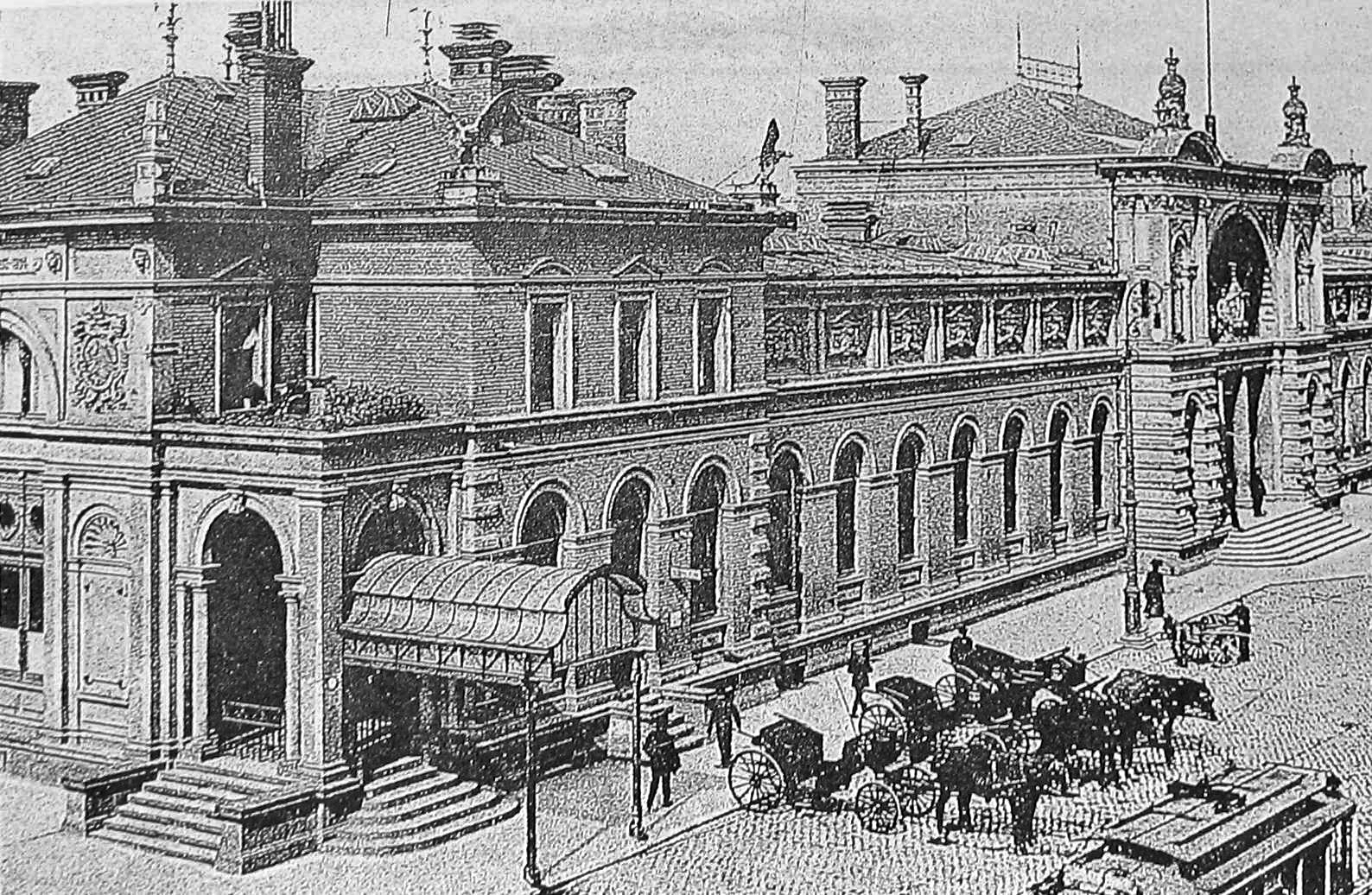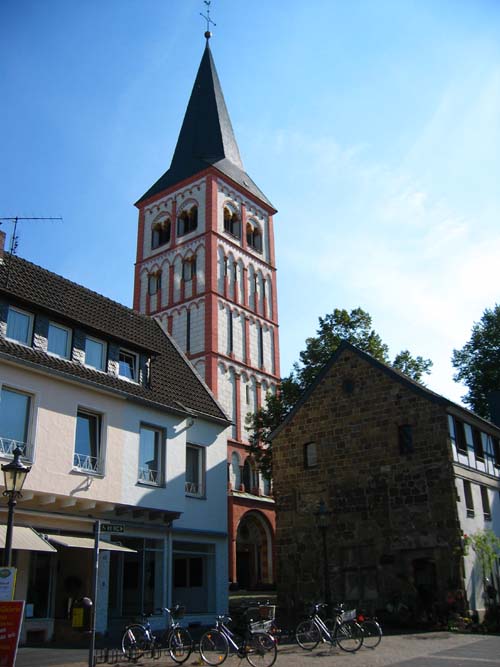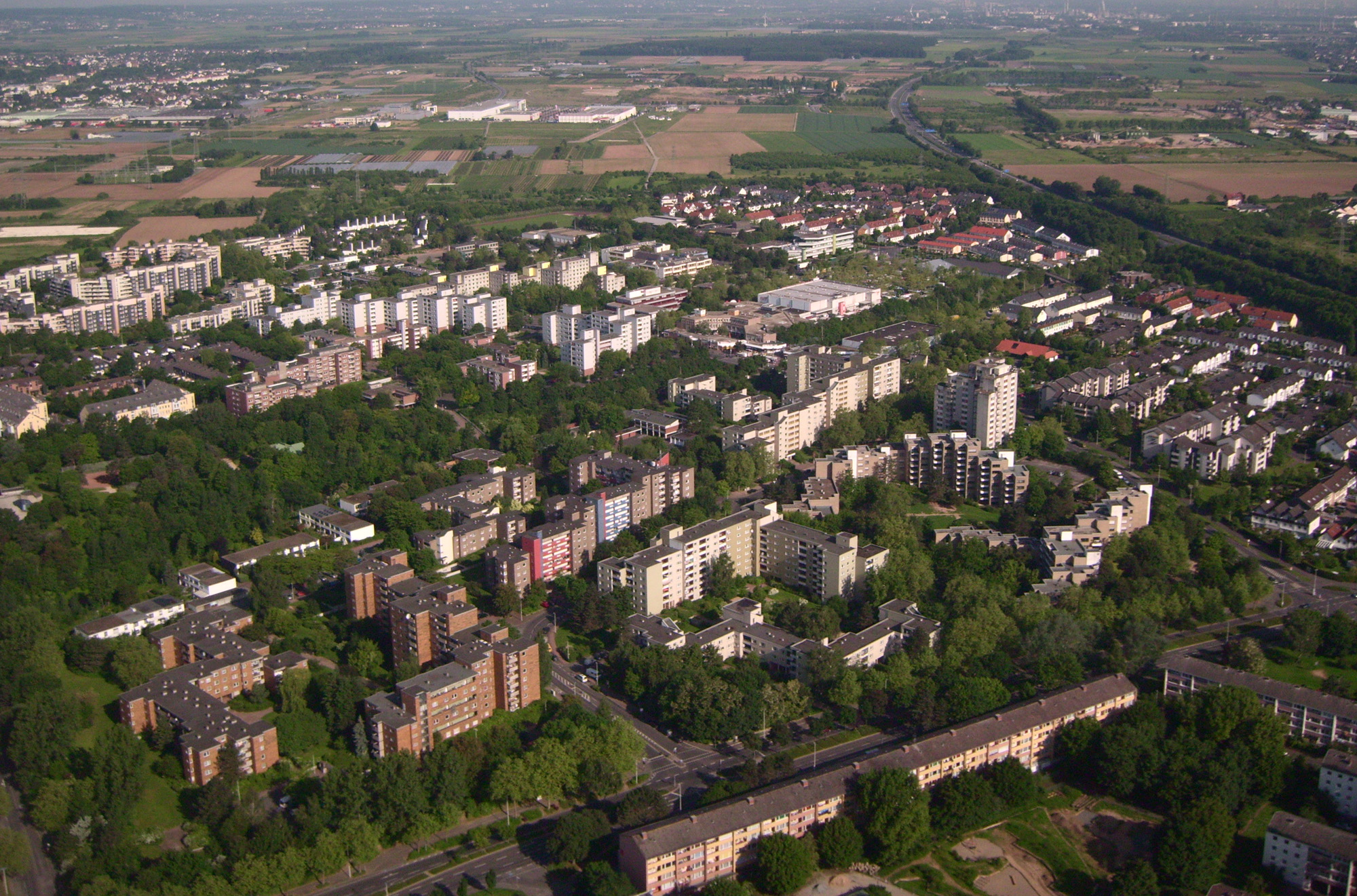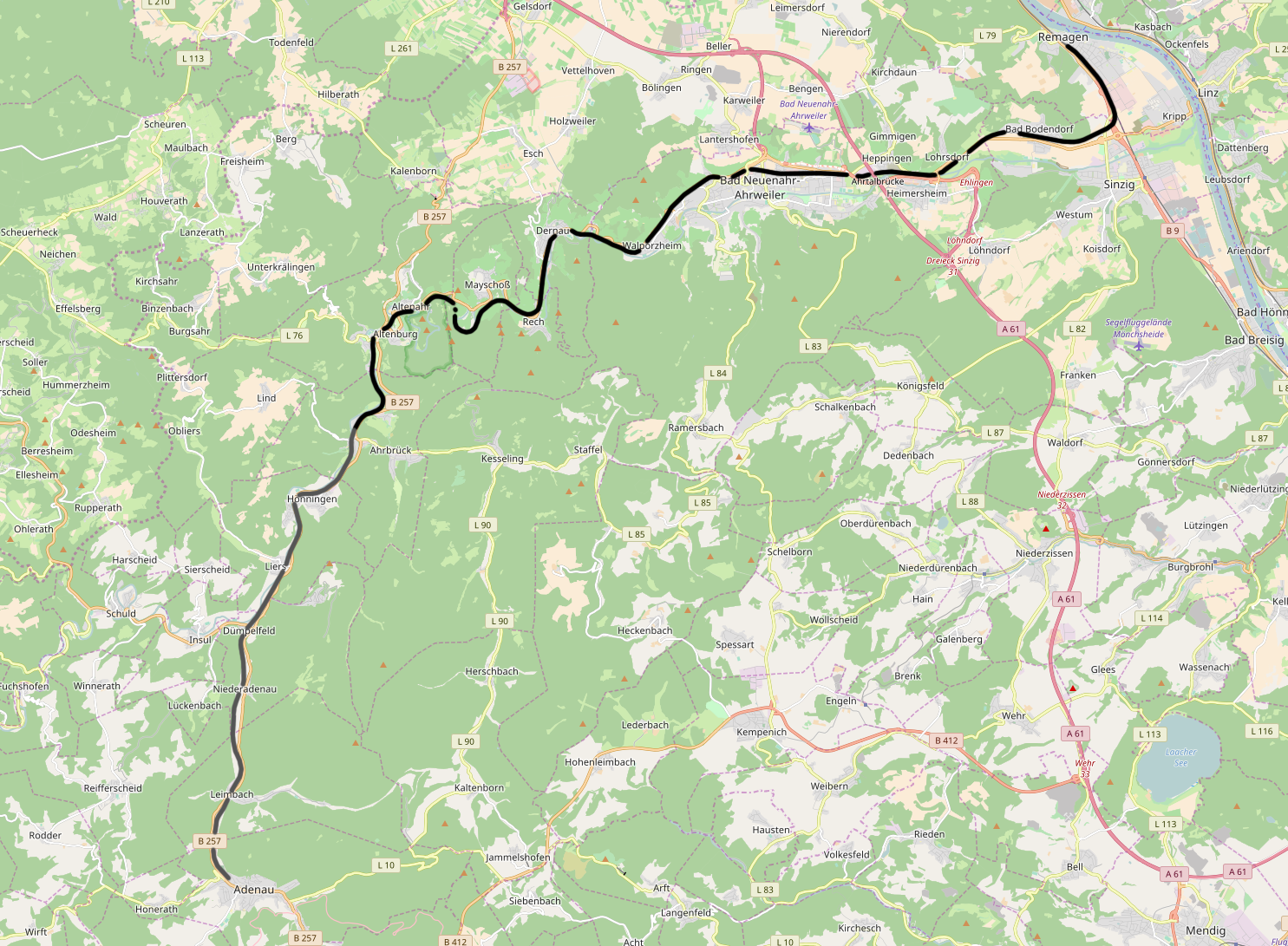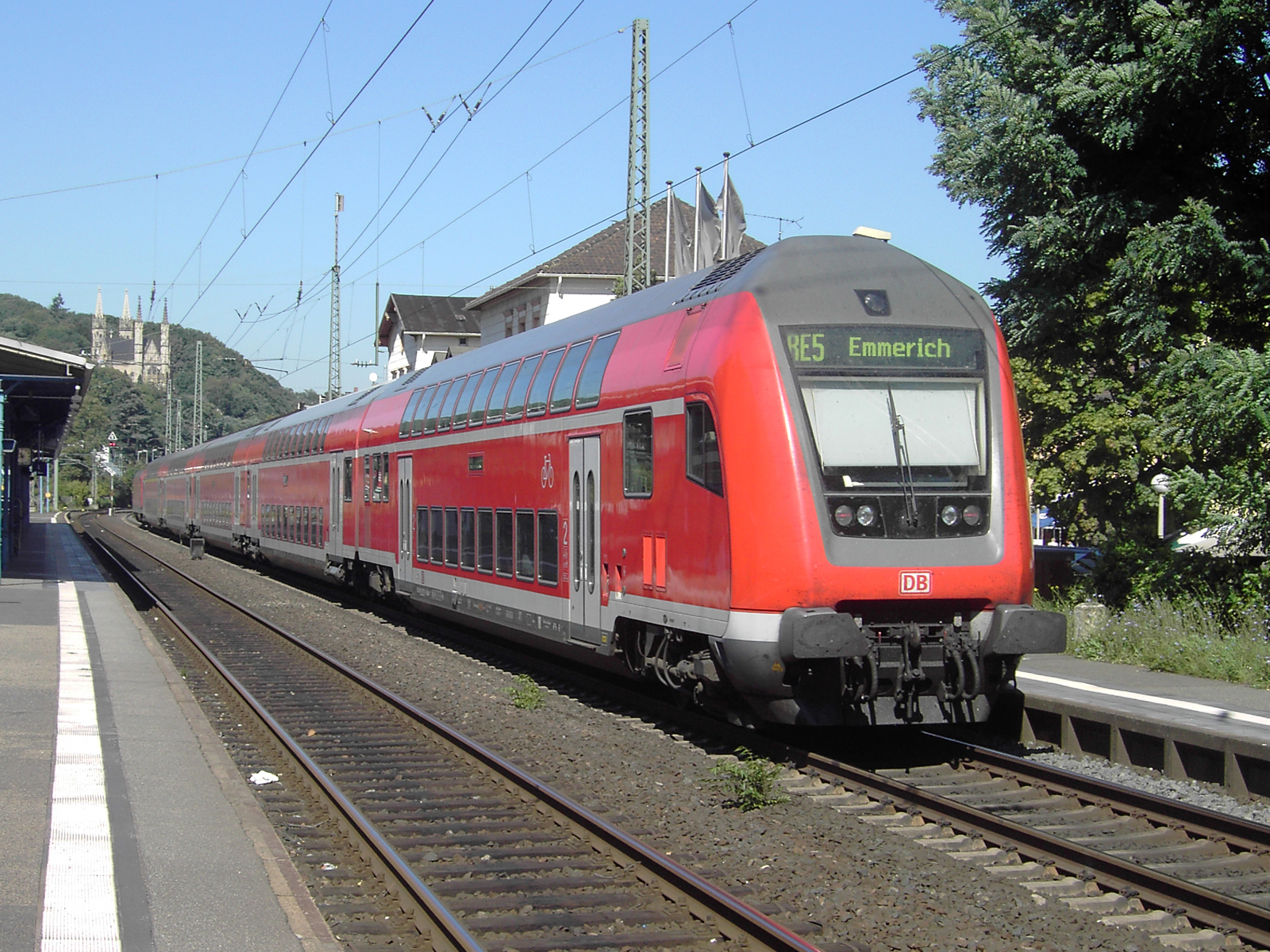|
Bonn-Bad Godesberg Station
Bonn-Bad Godesberg station is on the Left Rhine line (german: Linke Rheinstrecke) in the Bonn district of Bad Godesberg in the German state of North Rhine-Westphalia. It is a four-track through station, which does not have a “home” platform attached to the station building. Instead, it has two through and overtaking tracks on two island platforms, with one platform numbered 1 and 4 and the other 2 and 3, which is unusual in Germany, but occurs several times on the Left Rhine line. History The station was inaugurated on 15 October 1855 as part of the extension of the Left Rhine line from Bonn to Rolandseck station. The need for Godesberg station, which was then in open fields, was said to stem from the fact that Godesberg was the location of the summer homes of many shareholders of the Bonn–Cologne Railway Company and the president of the Rhenish Railway Company. For years the shareholders had a table in the station buffet and insisted on almost all trains stopping in Godes ... [...More Info...] [...Related Items...] OR: [Wikipedia] [Google] [Baidu] |
Bonn Stadtbahn
The Bonn Stadtbahn ('' en, city rail'') is a part of the local public transit system in Bonn and the surrounding Rhein-Sieg area, that also includes the Bonn Straßenbahn. Although with six actual Stadtbahn lines (as well as three tram lines) the network is relatively small, two of Bonn's Stadtbahn lines connect to the much larger Cologne Stadtbahn (and are numbered according to that system, not Bonn's). The Stadtbahn network comprises of route. There are 64 stations and stops in the city of Bonn proper, and another 17 in Siegburg and Bad Honnef. Additionally, of the Stadtbahn is located underground, as are 12 of the Stadtbahn stations. History In the middle of the 1960s Bonn lay at the heart of five different railway enterprises. Besides the Deutsche Bundesbahn (the West German national railway company) there was the independent Cologne-Bonn railway (KBE) and three separate tram concerns: *The tram network operated by the city of Bonn (SWB), which had declined in the 1950s ... [...More Info...] [...Related Items...] OR: [Wikipedia] [Google] [Baidu] |
Bonn Hauptbahnhof
Bonn Hauptbahnhof is a railway station located on the left bank of the Rhine along the Cologne–Mainz line. It is the principal station serving the city of Bonn. In addition to extensive rail service from Deutsche Bahn it acts as a hub for local bus, tram, and Stadtbahn services. History The first station was constructed in 1844 by the Bonn-Cologne Railway Company, as part of the West Rhine Railway. The current building was erected between 1883 and 1884. From 1870 a train ferry connected Bonn station to the East Rhine Railway. With the opening of the Voreifel Railway to Euskirchen, the station became a rail junction. In 1883 and 1884, a new station building was erected, which is now heritage listed. The station sharply increased in importance in 1949, when Bonn became capital of the Federal Republic. Many politicians and federal employees travelled by train, as did guests of the state. In 1969, Bonn grew considerably by incorporating towns which includes the stations of ... [...More Info...] [...Related Items...] OR: [Wikipedia] [Google] [Baidu] |
Siegburg
Siegburg (i.e. ''fort on the Sieg river''; Ripuarian: ''Sieburch'') is a city in the district of Rhein-Sieg-Kreis in North Rhine-Westphalia, Germany. It is located on the banks of the rivers Sieg and Agger, 10 kilometres from the former seat of West German government Bonn and 26 kilometres from Cologne. The population of the city was 39,192 in the 2013 census. Geography Siegburg is located approximately 8 kilometres east of the river Rhine, at the confluence where the Agger joins the Sieg, in the southeast corner of the Cologne Lowland. Neighbouring towns include Troisdorf, Lohmar, Sankt Augustin and Hennef. The nearby cities of Cologne and Bonn are easily accessible through good transport links. The highest point of the urban area is 220m above sea level ( NHN) in the Braschoß area and the lowest point is just under 54m above sea level at the mouth of the Agger. History Archbishop-Elector Anno II of Cologne founded a Benedictine monastery in 1064, known as Michaelsberg ... [...More Info...] [...Related Items...] OR: [Wikipedia] [Google] [Baidu] |
Tannenbusch
Tannenbusch is a section of Bonn, Germany with approx. 17,000 inhabitants. It is split between the subsections Alt-Tannenbusch and Neu-Tannenbusch. The roads in Tannenbusch are almost exclusively named after places in the former GDR and former eastern territories of Germany (e.g. Schlesienstrasse, Oppelner road, west Prussia route). Around 1949 – 1960 there was a US military camp in Tannenbusch. Of the inhabitants, 45% have a migrant background. About 40% of the inhabitants in the district live on state welfare payments. An Islamic salafi movement is active in the district. Alt-Tannenbusch Alt-Tannenbusch was a settlement at the northwest outskirts of the town of Bonn, which was first developed between the wars, and developed further in the early postwar years. Alt-Tannenbusch surrounds a dune, which is a nature reserve A nature reserve (also known as a wildlife refuge, wildlife sanctuary, biosphere reserve or bioreserve, natural or nature preserve, or nature conservation ... [...More Info...] [...Related Items...] OR: [Wikipedia] [Google] [Baidu] |
Köln
Cologne ( ; german: Köln ; ksh, Kölle ) is the largest city of the German western state of North Rhine-Westphalia (NRW) and the fourth-most populous city of Germany with 1.1 million inhabitants in the city proper and 3.6 million people in the urban region. Centered on the left (west) bank of the Rhine, Cologne is about southeast of NRW's state capital Düsseldorf and northwest of Bonn, the former capital of West Germany. The city's medieval Catholic Cologne Cathedral (), the third-tallest church and tallest cathedral in the world, constructed to house the Shrine of the Three Kings, is a globally recognized landmark and one of the most visited sights and pilgrimage destinations in Europe. The cityscape is further shaped by the Twelve Romanesque churches of Cologne, and Cologne is famous for Eau de Cologne, that has been produced in the city since 1709, and "cologne" has since come to be a generic term. Cologne was founded and established in Germanic Ubii terri ... [...More Info...] [...Related Items...] OR: [Wikipedia] [Google] [Baidu] |
Bonn BadGodesbergBahnhof
The federal city of Bonn ( lat, Bonna) is a city on the banks of the Rhine in the German state of North Rhine-Westphalia, with a population of over 300,000. About south-southeast of Cologne, Bonn is in the southernmost part of the Rhine-Ruhr region, Germany's largest metropolitan area, with over 11 million inhabitants. It is a university city and the birthplace of Ludwig van Beethoven. Founded in the 1st century BC as a Roman settlement in the province Germania Inferior, Bonn is one of Germany's oldest cities. It was the capital city of the Electorate of Cologne from 1597 to 1794, and residence of the Archbishops and Prince-electors of Cologne. From 1949 to 1990, Bonn was the capital of West Germany, and Germany's present constitution, the Basic Law, was declared in the city in 1949. The era when Bonn served as the capital of West Germany is referred to by historians as the Bonn Republic. From 1990 to 1999, Bonn served as the seat of government – but no longer capital – of ... [...More Info...] [...Related Items...] OR: [Wikipedia] [Google] [Baidu] |
Rhein-Wupper-Bahn
The Rhein-Wupper-Bahn is a Regionalbahn service in the German state of North Rhine-Westphalia. It connects the cities of Wuppertal, Solingen, Leverkusen, Cologne and Bonn and it is operated by National Express. Route The line runs mainly over the tracks of three railway lines: *from Wuppertal Hauptbahnhof to Gruiten station over the Düsseldorf–Elberfeld railway, built from 1838 to 1841 by the Düsseldorf-Elberfeld Railway Company, *from Gruiten to Köln-Mülheim station over the Gruiten–Köln-Deutz railway, opened on 25 September 1867 and 8 April 1868 by the Bergisch-Märkische Railway Company and *from Cologne Hauptbahnhof to Bonn-Mehlem over the West Rhine Railway, opened on 15 February 1844 by the Bonn–Cologne Railway Company and extended to Koblenz on 11 November 1858 by the Rhenish Railway Company. The trains of the Rhein-Wupper-Bahn (RB 48) stop at all stations on the line. They run daily from 5 am to 20 pm at hourly intervals between Wuppertal Hauptbahnhof and ... [...More Info...] [...Related Items...] OR: [Wikipedia] [Google] [Baidu] |
Ahr Valley Railway
The Ahr Valley Railway (german: Ahrtalbahn), Remagen–Ahrbrück, is currently a 29 km-long, partly single-track and non-electrified branch line, which runs through the Ahr valley from Remagen via Ahrweiler and Dernau to Ahrbrück in the German state of Rhineland-Palatinate. It is served by Regionalbahn services on lines RB 30 and RB 39 ( Deutsche Bahn timetable route number 477). History The history of the Ahr Valley Railway begins as a branch line of the West Rhine Railway (''Linke Rheinstrecke''). This line was built up the Rhine from Cologne to Rolandseck via Bonn by the Bonn–Cologne Railway Company (''Bonn-Cölner Eisenbahn-Gesellschaft'') between 1844 and 1856; it was extended to Bingerbrück via Remagen and Koblenz by the Rhenish Railway Company (''Rheinische Eisenbahn-Gesellschaft'') in 1858/59. On 23 September 1879, a ministerial decree was issued to authorise the building of the Ahr Valley Railway. Less than a year later, the Rhenish Railway opened t ... [...More Info...] [...Related Items...] OR: [Wikipedia] [Google] [Baidu] |
MittelrheinBahn
The West Rhine railway (German: ''Linke Rheinstrecke'', literally 'left (bank of the) Rhine route') is a famously picturesque, double-track electrified railway line running for 185 km from Cologne via Bonn, Koblenz, and Bingen to Mainz. It is situated close to the western (left) bank of the river Rhine and mostly aligned to allow 160 km/h operation between Cologne and Koblenz and between Bingen and Mainz. Line speed between Koblenz and Bingen is restricted by the meandering nature of the Rhine Gorge, a UNESCO World Heritage Site. History The first section of the line opened on 15 February 1844, by the Bonn–Cologne Railway Company (''Bonn-Cölner Eisenbahn-Gesellschaft'') between the former station of Cologne St. Pantaleon Cologne and Bonn. It was extended on 21 January 1856, south to Rolandseck station and in 1859 north to the Cologne central station. After the takeover by the Rhenish Railway Company (''Rheinische Eisenbahn Gesellschaft'', RhE) on 1 January 1857 t ... [...More Info...] [...Related Items...] OR: [Wikipedia] [Google] [Baidu] |
Rhein-Express
The Rhein-Express is a Regional-Express (RE 5 (RRX)) service, which generally follows the Rhine (german: Rhein) river. It runs daily every hour from 5 am to 9 pm from Wesel via Oberhausen, Duisburg, Düsseldorf, Cologne, Bonn, Remagen and Andernach to Koblenz, in the German states of North Rhine-Westphalia and Rhineland-Palatinate. It is the fourth-most used regional express line in the VRR network with approximately 48,000 passengers a day. Until the timetable change in December 2016, the Rhein-Express ran to/from Emmerich. Operations on this section and the additional services provided by Regionalbahn service RB 35 (''Der Weseler'') have since been operated as part of the Rhein-IJssel-Express (RE 19). History The ''Rhein-Express'' was established in 1998 with the introduction of the integrated regular interval timetable in North Rhine-Westphalia (called ''NRW-Takt'') by combining two services that previously started or finished in Cologne. Originally, the RE 5 service stop ... [...More Info...] [...Related Items...] OR: [Wikipedia] [Google] [Baidu] |
Deutsche Bahn
The (; abbreviated as DB or DB AG) is the national railway company of Germany. Headquartered in the Bahntower in Berlin, it is a joint-stock company ( AG). The Federal Republic of Germany is its single shareholder. describes itself as the second-largest transport company in the world, after the German postal and logistics company / DHL, and is the largest railway operator and infrastructure owner in Europe. Deutsche Bahn was the largest railway company in the world by revenue in 2015; in 2019, DB Passenger transport companies carried around 4.8 billion passengers, and DB logistics companies transported approximately 232 million tons of goods in rail freight transport. The group is divided into several companies, including ''DB Fernverkehr'' (long-distance passenger), '' DB Regio'' (local passenger services) and ''DB Cargo'' (rail freight). The Group subsidiary ''DB Netz'' also operates large parts of the German railway infrastructure, making it the largest rail network in ... [...More Info...] [...Related Items...] OR: [Wikipedia] [Google] [Baidu] |

